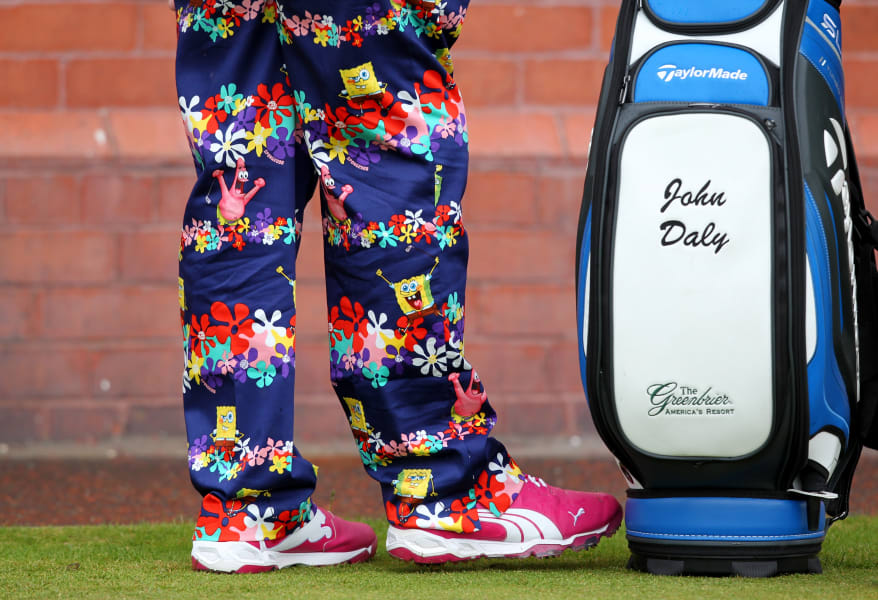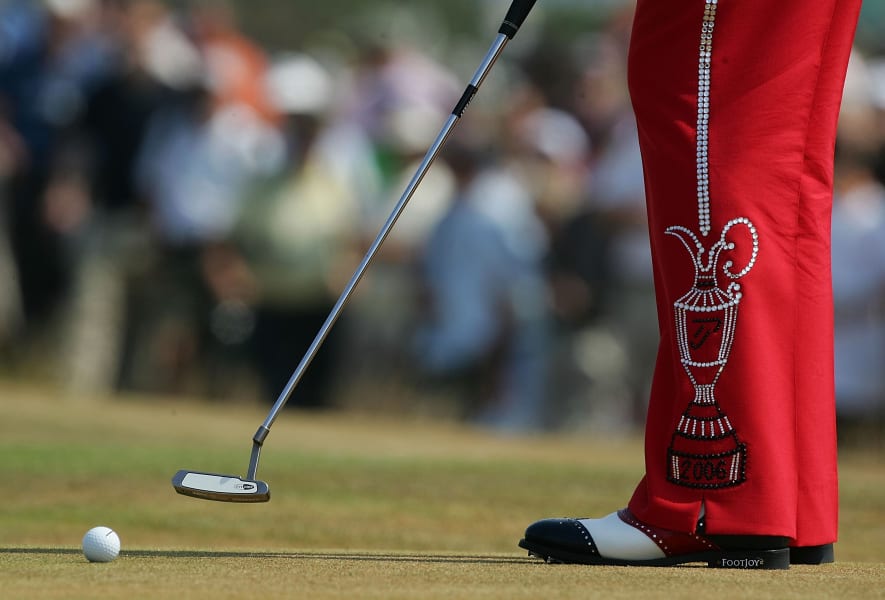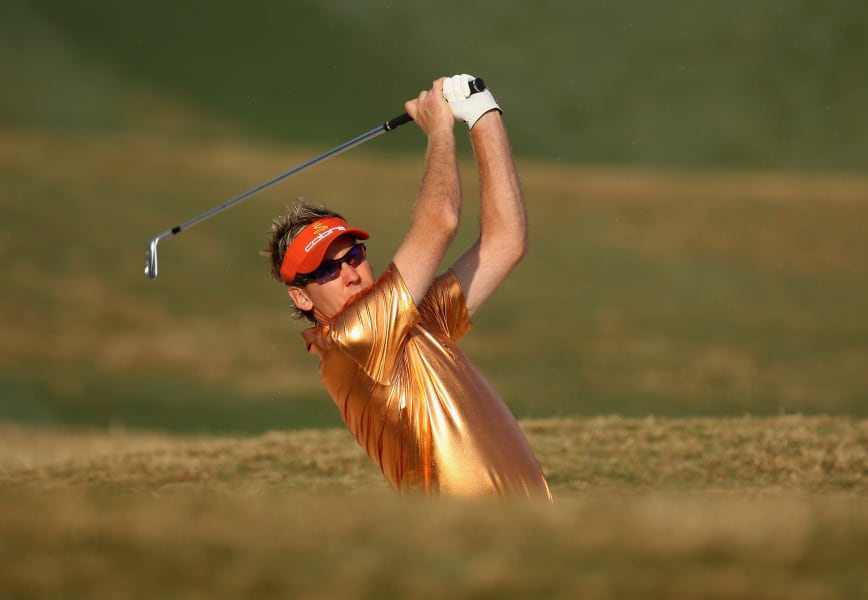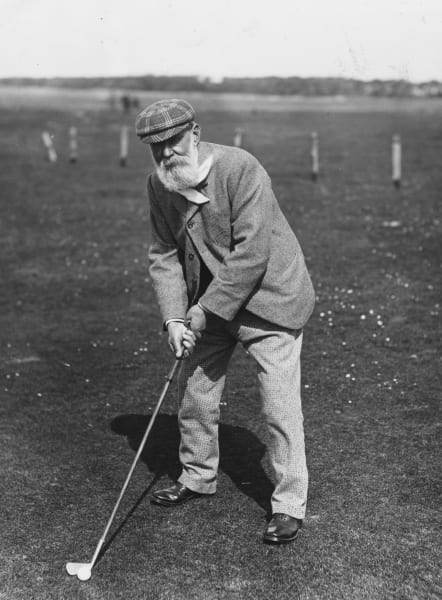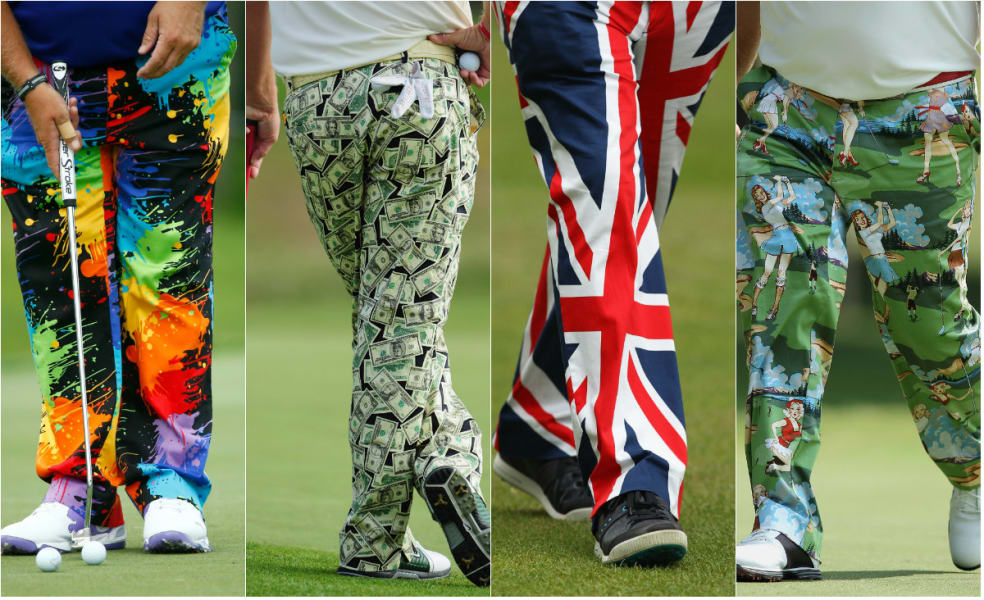Golf
How golf's fairway fashionistas shaped the look of the links
By Chris Borg & Matthew Knight, CNN
Updated 1040 GMT (1840 HKT) January 5, 2018
Share
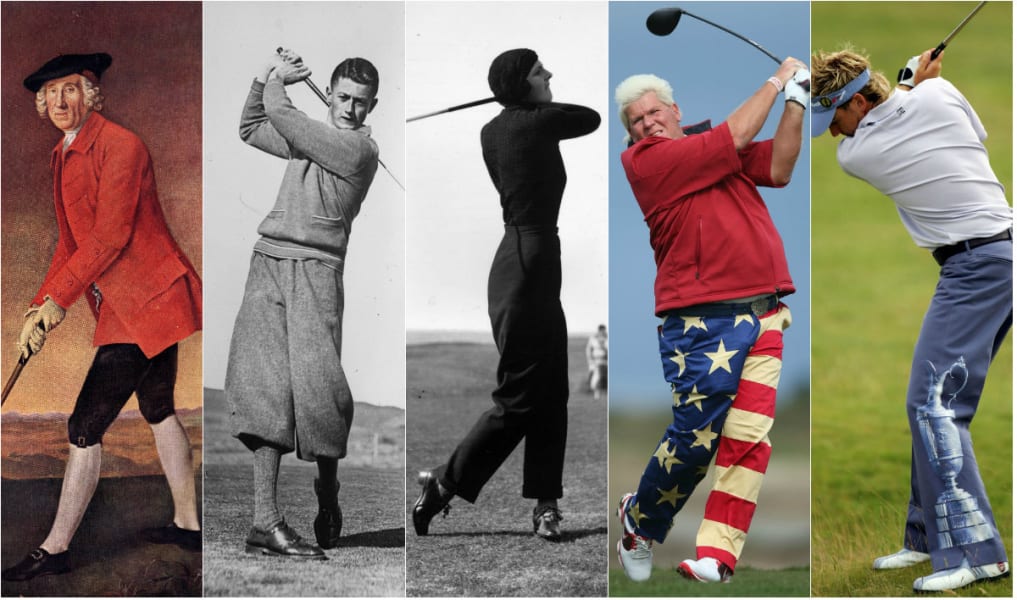

1 of 20
From the lurid colors of John Daly's trousers right back to the first swingers in the 17th century, golfers have always tried to stand out from the crowd. Gety Images/file
A portrait of William St. Clair of Rosslyn dating from around 1780. He was a member of the Honorable Company of Edinburgh Golfers (formerly known as the Gentleman Golfers of Edinburgh) who drew up the first known Rules of Golf. The military style coat was a familiar sight on the links in that era, Fleming says.
"Members of early golf societies in Scotland and England from the early 1700s onwards were quite frequently military men who would often have military style coats -- it was the fashion of the day to wear a button coat," Fleming told CNN.
"Different societies had different colors -- red is an R&A color and other societies also wore red, but others wore blue, green, there are instances of yellow (coats). It was symbol of membership. They would have special buttons for different societies, in the same way today that clubs have their own crest on jumpers and jackets, blazers, club ties. They also served a practical purpose -- they were warm and highly visible." Hulton Archive/Getty Images
"Members of early golf societies in Scotland and England from the early 1700s onwards were quite frequently military men who would often have military style coats -- it was the fashion of the day to wear a button coat," Fleming told CNN.
"Different societies had different colors -- red is an R&A color and other societies also wore red, but others wore blue, green, there are instances of yellow (coats). It was symbol of membership. They would have special buttons for different societies, in the same way today that clubs have their own crest on jumpers and jackets, blazers, club ties. They also served a practical purpose -- they were warm and highly visible." Hulton Archive/Getty Images
Old Tom Morris, photographed around 1880, won the Open Championship four times. Dressed in hard-wearing and warm tweed, Morris, the son of a weaver, is widely regarded as the first professional golfer.
"The early Open champions started to be known as pros," explains Fleming. "They won money in competitions and were backed by the gentlemen golfers who would act almost like sponsors. They would bet against one another, put up prize money, trophies." Hulton Archive/Getty Images/file
"The early Open champions started to be known as pros," explains Fleming. "They won money in competitions and were backed by the gentlemen golfers who would act almost like sponsors. They would bet against one another, put up prize money, trophies." Hulton Archive/Getty Images/file
A young King Edward VIII (right) seen here in 1916. Then the Prince of Wales, he was a golf lover and wore "typical golfing dress rather than royal wear," Fleming says. His relaxed choice of clothing extended to wearing Fair Isle sweaters, which he helped popularize. The distinctive, multicolored weave is named after the small island in Shetland off Scotland's northeast coast.
When Edward was appointed Captain of the Royal and Ancient Golf Club in 1922, a crowd of 6,000 onlookers watched him complete the "Drive into Office" (a ceremony on the first tee to mark the start of a new club captain's tenure) wearing a round-neck Fair Isle sweater.
"Knitwear became a look of its own and people would wear it outside the golf course -- thanks in part to Scottish knitwear companies like Pringle and Lyle and Scott," Fleming says. Keystone/Getty Images
When Edward was appointed Captain of the Royal and Ancient Golf Club in 1922, a crowd of 6,000 onlookers watched him complete the "Drive into Office" (a ceremony on the first tee to mark the start of a new club captain's tenure) wearing a round-neck Fair Isle sweater.
"Knitwear became a look of its own and people would wear it outside the golf course -- thanks in part to Scottish knitwear companies like Pringle and Lyle and Scott," Fleming says. Keystone/Getty Images
U.S. golf star Walter Hagen (left) shakes hands with Britain's Henry Cotton after the American won his fourth and final Open Championship at Muirfield in 1929. Dressed in plus fours, shirts, ties and v-neck sweaters, the pair were a dapper sight on the course.
"Walter Hagen loved wearing smart clothing and was known to talk about being a millionaire. He really liked bright colors," Fleming said. Topical Press Agency/Getty Images/file
"Walter Hagen loved wearing smart clothing and was known to talk about being a millionaire. He really liked bright colors," Fleming said. Topical Press Agency/Getty Images/file
Australian golfer Harry Williams sported a particularly fine pair of plus fours, or knickerbockers as they were more commonly known, in 1931.
"People always ask about the plus four and the plus two -- the difference is the width of fabric that's left at the knee. Plus fours equals four inches of fabric at the knee," Fleming says.
"If you ask people to name the traditional golfing look, it's diamond jumpers and plus fours. They were worn for lots of outdoor pursuits and golfers took to the knickerbockers. Even at the time people debated whether you looked silly!" Fox photos/Getty Images/file
"People always ask about the plus four and the plus two -- the difference is the width of fabric that's left at the knee. Plus fours equals four inches of fabric at the knee," Fleming says.
"If you ask people to name the traditional golfing look, it's diamond jumpers and plus fours. They were worn for lots of outdoor pursuits and golfers took to the knickerbockers. Even at the time people debated whether you looked silly!" Fox photos/Getty Images/file
The late American golfer Payne Stewart revived the fashion for wearing plus fours and plus twos before his tragic death in 1999.
"People sometimes turn up at St. Andrews to play the Old Course in plus fours because they want to wear this great outfit. Payne Stewart loved to wear outrageous things," Fleming says. Gary NewkirkAllsport/file
"People sometimes turn up at St. Andrews to play the Old Course in plus fours because they want to wear this great outfit. Payne Stewart loved to wear outrageous things," Fleming says. Gary NewkirkAllsport/file
Female golf attire wasn't exactly progressive in the late 19th and early 20th centuries. This outfit from circa. 1890 was typical of the heavy garb that women would wear.
"They were passionate about the game and careful about how they were perceived. They wanted to keep a good reputation," Fleming says. Topical Press Agency/Getty Images/file
"They were passionate about the game and careful about how they were perceived. They wanted to keep a good reputation," Fleming says. Topical Press Agency/Getty Images/file
"A dainty and most becoming garment..." Two decades later and fashions were starting to change, as this advert from 1910 suggests. Hulton Archive/Getty Images/file
Four first-round competitors in a Ladies' Scottish Foursomes tournament on the Royal and Ancient Course in June 1928.
Women golfers would sometimes wear what was called a "Miss Higgins Hoop."
"It was really just a piece of elastic that was moved up to around their knees and designed to keep your skirt from blowing up in the wind -- women had to remain modest. Often what would happen is that they would weight their skirts with wire along the bottom edge rather than having the Miss Higgins Hoop," Fleming says.
"During the 1920s and 1930s women's fashion in general changed -- there was less corsetry -- so golf fashion kind of reflects wider fashions." L. Blandford/Topical Press Agency/Getty Images
Women golfers would sometimes wear what was called a "Miss Higgins Hoop."
"It was really just a piece of elastic that was moved up to around their knees and designed to keep your skirt from blowing up in the wind -- women had to remain modest. Often what would happen is that they would weight their skirts with wire along the bottom edge rather than having the Miss Higgins Hoop," Fleming says.
"During the 1920s and 1930s women's fashion in general changed -- there was less corsetry -- so golf fashion kind of reflects wider fashions." L. Blandford/Topical Press Agency/Getty Images
The elegant and striking figure of Gloria Minoprio caused a sensation at the English Ladies' Golf Championship in 1933 when she arrived carrying just one club and wearing trousers -- a first for a women golfer.
"She turned up using a one iron and wore an iconic outfit -- a pair of navy trousers quite high-waisted and well-fitting, a roll-neck sweater and a turban, all matching navy colors," Fleming says.
"From that period onwards, more golfing women thought, 'Well, maybe I could wear slightly more interesting fashion choices on the golf course.'"
Hulton Archive/Getty Images/file
"She turned up using a one iron and wore an iconic outfit -- a pair of navy trousers quite high-waisted and well-fitting, a roll-neck sweater and a turban, all matching navy colors," Fleming says.
"From that period onwards, more golfing women thought, 'Well, maybe I could wear slightly more interesting fashion choices on the golf course.'"
Hulton Archive/Getty Images/file
Max Faulkner, Open champion in 1951, was a colorful presence on the fairways during the 1950s and 1960s.
"He loved to wear bright colors and was known for being quite fun on the course. He was somebody who looked to make use of fashion," Fleming says. Don Morley/Getty Images/file
"He loved to wear bright colors and was known for being quite fun on the course. He was somebody who looked to make use of fashion," Fleming says. Don Morley/Getty Images/file
Arnold Palmer teeing off at the 1960 Masters tournament. The American's victories at the 1961 and 1962 Open Championship helped revive interest in the sport's oldest and most prestigious trophy.
"I would like to be remembered for bringing golf to a worldwide audience," Palmer, who was known for his stylish presence on the course, told CNN in 2012.
"I liked a sharp crease in my slacks, my shoes polished to shine, while my shirts were conservative with a straight collar. It was a style I stuck with for most of my career." Augusta National/Getty Images
"I would like to be remembered for bringing golf to a worldwide audience," Palmer, who was known for his stylish presence on the course, told CNN in 2012.
"I liked a sharp crease in my slacks, my shoes polished to shine, while my shirts were conservative with a straight collar. It was a style I stuck with for most of my career." Augusta National/Getty Images
Palmer's exploits in the UK inspired a young Jack Nicklaus to compete at the Open Championship. The 18-time major champion is pictured here at St. Andrews' Old Course in 1978, when he would win his third and final Claret Jug. Both Nicklaus, dubbed the "Golden Bear," and Arnold "The King" Palmer would exploit their on-course success with profitable clothing businesses off it. Steve Powell/Allsport
Both Nicklaus and Palmer built successful clothing brands. Nicklaus' distinctive "Golden Bear" logo is known to golfers throughout the world and Palmer, with the help of the sports agent Mark McCormack, settled on an umbrella logo for his wares.
"People of that era did become more aware of branding and Jack Nicklaus was an early pioneer in that," Fleming says. Getty Images/file
"People of that era did become more aware of branding and Jack Nicklaus was an early pioneer in that," Fleming says. Getty Images/file
The trend of standing out on the links has been given new meaning by former Open champion John Daly in recent years. Although when he posed on St. Andrews' Swilcan Bridge with the Claret Jug in 1995, he wasn't quite so colorfully dressed. J.D. Cuban/Getty Images
Known as "Wild Thing," Daly has cultivated a reputation for wearing exuberant designs, notably his garish trousers. Getty Images
Here's a pair he wore at last year's Open Championship at Hoylake. What will he wear this year? Peter Muhly/AFP/Getty Images/file
Britain's Ian Poulter has also earned a reputation for his loud clothing as much as his attacking golf. David Cannon/Getty Images
Poulter, seen here playing at New Delhi in 2008, has built a successful clothing business, IJP Design, and is unapologetic about what he wears during tournaments -- even this gold lamé top.
"I wear what I want to wear as opposed to wearing what someone else wants me to wear," he told CNN earlier this year. "I'm quite a control freak from that standpoint. I like what I wear, so it's good for me to be able to promote that." David Cannon/Getty Images/file
"I wear what I want to wear as opposed to wearing what someone else wants me to wear," he told CNN earlier this year. "I'm quite a control freak from that standpoint. I like what I wear, so it's good for me to be able to promote that." David Cannon/Getty Images/file
